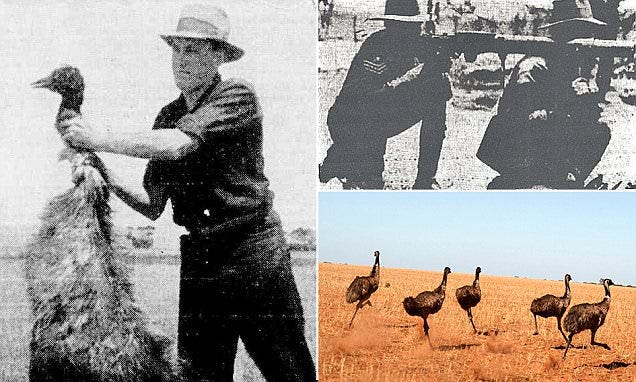In the annals of military history, conflicts are typically waged between human adversaries, but there exists a curious anomaly: the Great Emu War of Australia. This unusual chapter in warfare saw the Australian military pitted against a formidable foe – the emu, a large flightless bird native to the continent. In this blog, we delve into the fascinating story of the Great Emu War, exploring its origins, course of events, and ultimate outcome.
The Origins:
The stage for the Great Emu War was set in the aftermath of World War I, during the 1930s, in Western Australia. Following the war, many Australian veterans found themselves facing economic hardship, prompting the government to offer land grants for farming in the Western Australian region of Campion. However, the fertile farmlands soon faced a significant challenge from an unexpected source: the emu population, which had flourished in the absence of natural predators.
The Conflict Begins:
As the emu population grew rapidly, farmers in Campion found their crops under siege from the hungry birds. The emus, known for their voracious appetites and destructive feeding habits, descended upon the wheat fields in large flocks, causing widespread damage and devastation. Frustrated by their inability to control the emu population through traditional means, such as hunting, the farmers turned to the government for assistance.
The Military Intervention:
In response to the escalating emu problem, the Australian government deployed a contingent of soldiers armed with Lewis guns, a type of light machine gun, to the Campion region in November 1932. Led by Major G.P.W. Meredith, the soldiers were tasked with culling the emu population and protecting the farmers’ crops. The stage was set for an unconventional conflict between man and bird.
The Battles:
The soldiers soon found themselves engaged in a series of skirmishes with the emus across the vast plains of Western Australia. However, the emus proved to be elusive and formidable adversaries, employing their speed and agility to evade the soldiers’ gunfire. Despite their best efforts, the soldiers struggled to inflict significant casualties on the emu population, leading to frustration and setbacks.
The Outcome:
After several weeks of intense fighting, marked by logistical challenges and tactical difficulties, the military campaign against the emus was ultimately deemed a failure. Despite the soldiers’ efforts, the emu population remained largely intact, and the farmers continued to suffer losses to their crops. In the end, the government withdrew its forces from the region, conceding defeat in what would come to be known as the Great Emu War.
The Legacy:
Although the Great Emu War ended in failure for the Australian military, it left behind a legacy of humor, absurdity, and resilience. The conflict became the subject of widespread ridicule and satire, with many dubbing it “the war that Australia lost to birds.” Nevertheless, the emu problem persisted, prompting the government to explore alternative methods of population control, such as bounty schemes and fencing.
Conclusion:
The Great Emu War stands as a testament to the unpredictable nature of warfare and the resilience of nature’s adversaries. Despite the best efforts of the Australian military, the emus emerged victorious, their population remaining largely unchecked in the vast expanses of Western Australia. As we reflect on this curious chapter in history, we are reminded of the ingenuity, adaptability, and indomitable spirit of the natural world, which continues to defy human efforts to control and subdue it.























